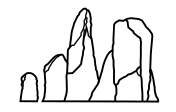COULEUR DU TEMPS. Altérations chromatiques et pseudo-peintures néolithiques observées sur les parois des tombes monumentales du Morbihan
20,00 €
CASSEN (Serge), BLANK (Malou), QUERRE (Guirec), SCHULZ-PAULSSON (Bettina), VERGES-BELMIN (Véronique), GRIMAUD (Valentin)
Description
CASSEN (Serge), BLANK (Malou), QUERRE (Guirec), SCHULZ-PAULSSON (Bettina), VERGES-BELMIN (Véronique), GRIMAUD (Valentin), 2023. COULEUR DU TEMPS. Altérations chromatiques et pseudo-peintures néolithiques observées sur les parois des tombes monumentales du Morbihan. Nantes / Carnac ; LARA / Les Vaisseaux de Pierres. 2023.
Résumé :
La présente étude expose les problèmes inhérents à certaines tombes néolithiques du Morbihan, où des colorations considérées comme des peintures ont été notées sur des monolithes depuis le XIXe siècle, en règle générale associées à des signes gravés. Plusieurs cas de figure seront décrits, limités aux dalles des parois latérales et aux plafonds des tombes (aucune stèle ne présente de dépôt de cette nature).
Pour répondre sincèrement à cette question, il a fallu au préalable distinguer les altérations chromatiques (oxydations diverses à l’image d’une rubéfaction, et les différentes tâches) et les dépôts superficiels (endogènes comme les patines, les croûtes gypseuses ; ou exogènes comme l’application de colorants, de graffiti).
Du côté des analyses quantitatives, les méthodes non invasives ont bien sûr été testées en premier (spectrométrie de fluorescence X portable) mais l’absence de résultats significatifs a souvent imposé de prolonger l’enquête au moyen de prélèvements ponctuels permettant des analyses élémentaires et structurelles (microscopie électronique à balayage et spectroscopie à dispersion d’énergie), moléculaires (spectroscopie infrarouge à transformée de Fourier) et cristallines (diffraction des rayons X), voire, dans le cas de Gavrinis, bactériologiques. Les images électroniques des échantillons et leurs spectres, les analyses en composantes principales ont fait l’objet d’une annexe disponible en ligne. La cartographie de ces interventions est aidée d’un traitement de l’image numérique (par décorrélation) qui fait ressortir les différentes anomalies ; l’espace de couleur retenu et l’échelle adoptée sont systématiquement mentionnés de telle sorte que l’expérience puisse être reproduite et contrôlée.
Il ne s’agit pas de restituer ici un inventaire exhaustif mais d’aborder quelques objets gravés observés dans le cadre des investigations conduites sur Gavrinis (2011-2014) et sur les ensembles iconographiques du Morbihan (dans le cadre d’un Programme collectif de recherche 2016-2022). Au terme de ces enquêtes, force est de constater qu’aucune application de peinture néolithique n’a pu être démontrée.
Abstract :
“Couleur du temps”: mutable, indefinable colour. Chromatic alterations and Neolithic pseudo-painted designs observed on the walls of monumental tombs in the Morbihan
This study reveals the problems that are inherent in some Neolithic tombs in the Morbihan where, since the 19th century, observers have noted colouration on the stones, generally associated with engraved designs, which they have interpreted as painted decoration. Several cases of this will be described; they are limited to the slabs of the lateral walls and the ceilings of the tombs. (No example of this colouration has been seen on any standing stone.)
In order to deal objectively with this question, it was first necessary to differentiate between types of chromatic alteration (namely various kinds of oxidation that resemble burn-marks, and various patches of discolouration) and superficial deposits, whether they be endogenous (such as forms of patina and efflorescences of gypsum-like material from the stone) or exogenous (such as the application of colourants or the addition of graffiti).
Concerning the application of quantitative analytical methods, we first tested out non-invasive methods (portable X-ray fluorescence spectroscopy) but the absence of meaningful results necessitated the taking of small samples instead. These samples were subjected to elemental and structural analysis using an energy-dispersive scanning electron microscope; to molecular-level analysis using Fourier-Transform Infra-Red spectroscopy; and to crystalline analysis using X-ray diffraction spectroscopy. In the case of Gavrinis, bacteriological analysis was also undertaken.
The electronic images of the samples and their spectra, together with the results of principal components analysis, are available as an online annexe. The mapping of the sample areas has been facilitated by digital imaging (using decorrelation), which has allowed the various anomalies to stand out. We have systematically recorded the colour space and the scale used (ImageJ/DStretch) to record the data so that our work could be replicated in a controlled manner.
We did not set out to create an exhaustive inventory; rather, we focussed on certain engraved designs that we noticed during our investigations at Gavrinis (2011–2014), and on others within the iconographic repertoire of the Morbihan. The latter work was undertaken as part of our Programme collectif de recherche 2016–2022. We were forced to conclude from our investigations that there is no evidence for Neolithic painting in these monuments.
Informations complémentaires
| Poids | 0,315 kg |
|---|



